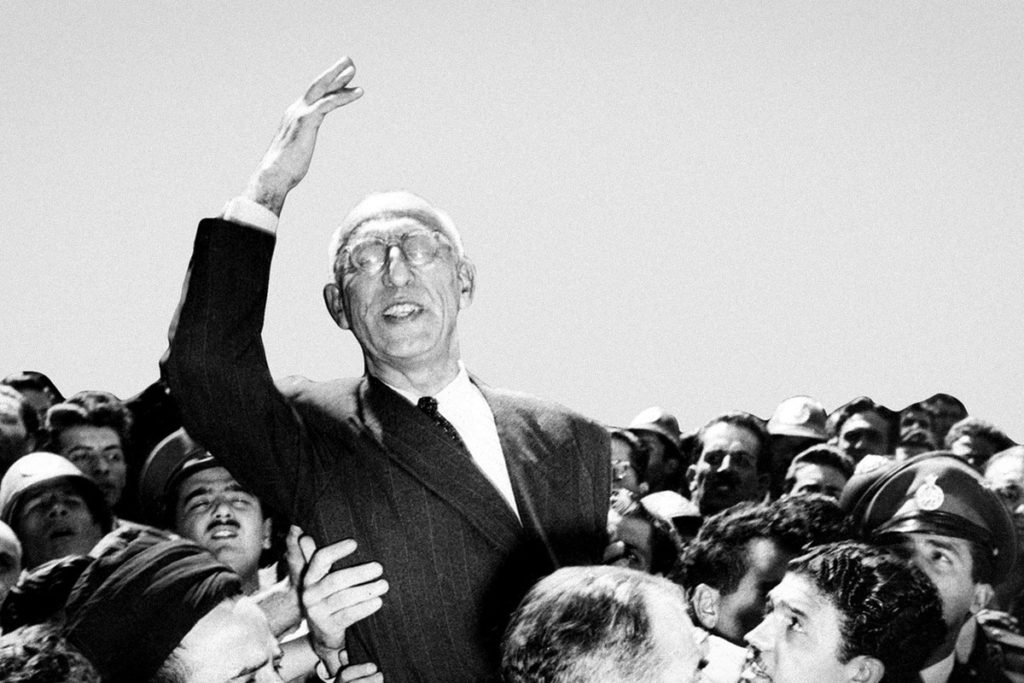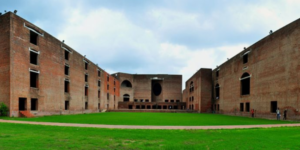Iran’s Revolution is generally understood to have begun on January 7, 1978, and continued until the Shah fled the country on January 16, 1979. The revolution was brewing for decades though — or for millennia, as some argue: the Shahs had ruled Persia, more or less, for well over two thousand years.
Let’s take a quick look at recent history. Oil was discovered in Iran in 1908. The UK company APOC bought the rights to control the Iranian oil industry until 1945. During WWII the Allies invaded Iran to ensure control over their oil.
The Allies needed a new and obedient king (or Shah) for Iran. Inconveniently for their neocolonial plans, the heir to the throne, Hamid Hassan Mirza, didn’t speak any Persian and was a British citizen, so they installed Mohammad Reza Pahlavi. Pahlavi’s military dictatorship ruled Iran for 38 years, but he would prove to be the last Shah of Iran.
During the post-war years, with the weakening of the British empire, the US began to take a leading role in controlling Iran’s oil industry & maintaining the Shah’s brutal regime. The CIA’s Kermit Roosevelt called Pahlavi “our boy,” and the US (with the help of apartheid Israel) created the SAVAK secret police for Pahlavi.
Kermit Roosevelt & Mohammad Mossadegh
Roosevelt “admitted in his memoirs that SAVAK was 100% created by the CIA and Mossad,” writes Dan Kovalik. “350 SAVAK agents were shuttled each year to CIA training facilities in McLean, Virginia, where they learned the finer arts of interrogation and torture… Popular anger towards Big Oil, the Shah and his new police state resulted in mass protests. The Shah dealt with the peaceful demonstrations with sheer brutality and got a wink and nod from Langley. From 1957–79 Iran housed 125,000 political prisoners. SAVAK “disappeared” dissenters, a strategy replicated by CIA surrogate dictators in Argentina and Chile… In 1974 the director of Amnesty International declared that no country had a worse human rights record than Iran. The CIA responded by increasing its support for SAVAK… The SAVAK was the original incubator used by the CIA to develop its torture techniques for world-wide distribution.”¹
In 1951 Mohammad Mossadegh became Prime Minister of Iran, leading a popular movement demanding democratic representation within the Shah’s rule, and promising to nationalize the oil industry and help alleviate poverty in Iran. His rise would be short lived. “His government was overthrown in the 1953 Iranian coup d’état orchestrated by the United States’ Central Intelligence Agency and the United Kingdom’s MI6… Mosaddegh was imprisoned for three years, then put under house arrest until his death and was buried in his own home so as to prevent a political furor. In 2013, the US government formally acknowledged the US role in the coup, as a part of its foreign policy initiatives.”²
This coup is very instructive to read about: the CIA weaponized ongoing protests against the Shah, planting their own violent protestors into the chaos. Then US Ambassador Henderson told Mossadegh that he was worried about the safety of US citizens in Iran.
“The riots that shook Tehran on Monday intensified on Tuesday,” writes Stephen Kinzer of the 1953 protests. “Thousands of demonstrators, unwittingly under CIA control, surged through the streets, looting shops, destroying pictures of the Shah, and ransacking the offices of royalist groups. Exuberant nationalists and communists joined in the mayhem. The police were still under orders from Mossadegh not to interfere. That allowed rioters to do their jobs, which was to give the impression that Iran was sliding towards anarchy. Roosevelt caught glimpses of them during his furtive trips around the city and said that they ‘scared the hell out of him.’”³
After receiving the Ambassador’s veiled warning Mossadegh sent police out to quell the mobs, which actually included many of his movement’s supporters. Mossadegh was then blamed for the repression and arrested in the middle of the night, all according to a clear plan detailed in CIA memos. His arrest is particularly reminiscent of Manuel Zelaya’s arrest in 2009, while in his pyjamas, by US-backed forces who deposed the elected president of Honduras.
SAVAK blamed Mossadegh for the violence and also for the ensuing repression. Him and his supporters were rounded up, as well as thousands of communists for good measure, and the Shah’s dictatorial powers were increased, as was his funding — Pahlavi received a $45 million bonus in 1953.⁴ This put a quick end to Iran’s experiment with limited democracy. As the Shah’s fascist stance increased the CIA actually went on to “work with Nazi sympathizers in Iran,” and swastikas could be seen flying in the Shah’s military parades.⁵
Meanwhile the UK and the US reversed the nationalization of oil, and split all the assets between themselves: UK companies got 40 percent, the US got 40 percent, and Dutch and French companies got the rest. For orchestrating the coup, Kermit Roosevelt was rewarded with the vice-presidency of Gulf Oil.
Ayatollah Ruhollah Khomeini, Supreme Leader of the Iranian Revolution
Ruhollah Khomeini was a revolutionary, anti-imperialist author and spiritual leader of those protesting the Shah’s brutal rule. For speaking against the dictatorship he was imprisoned in 1963. This led to gigantic protests across the country. The Shah responded by ordering police to fire on demonstrators — 15,000 were killed according to historians of the Iranian Revolution.
In 1965 Khomeini was exiled to Iraq, where he continued to write and function as a leader of the anti-Shah movement. By the late ’70s demonstrations against the Shah’s dictatorship were becoming simply massive. Repression was accordingly immense.
In January 1978 an article in the dictatorship’s Ettela’at newspaper denounced Khomeini as a “British agent” conspiring to sell out Iran to neo-colonialists and communists. Anger at this article caused an uprising, which of course was brutally repressed, leading to larger and larger protests across the country. The dictatorship banned dissident literature, and the Shah’s US sponsors were aware that — in addition to the tens of thousands being murdered, disappeared, and imprisoned — “thousands of children” were killed for reading banned books.
“Street marches in Tehran were more than a million strong,” wrote the late historian Robert Fisk. At a September 1978 demonstration, police open fire on demonstrators in Jaleh square, killing 4,000.⁶
“Imagine,” writes Kovalik. “Four thousand people killed in one demonstration! If such a thing happened in Venezuela or Cuba, or in Iran in 2018, this would be cause for the United States to send in the 82nd Airborne. In addition, such an event would be cause for great media fanfare if it happened, say, in China, for example, during the Tiananmen Square protests ten years later in which three hundred to three thousand protestors were killed.” Of course the Jaleh massacre goes almost unmentioned in Western history courses, even at university level.⁷
The US, now under Jimmy Carter, supported the Shah dictatorship until the end. When finally unable to prop him up anymore, after every military option had failed, the US invited him to New York and provided him asylum.
While the Shah was in New York, Khomeini returned to Iran. A referendum was taken asking Iranians if they wanted to replace the monarchy with an Islamic Government. A resounding 98 percent answered in the affirmative.
Carter refused to apologize for the US role in installing and paying the Shah, creating his security apparatus, and maintaining his rule.
In 1978, as the Revolution was unfolding, in an astounding display of hypocrisy Carter praised the Shah and claimed that the “stability” of Iran was “a great tribute to the respect, admiration and love of your people for you.”⁸ We’re reminded of US leaders’ hubris upon assassinating General Soleimani in 2020, when Pompeo & the empire’s agents boasted that this would bring “freedom” to Iran and lead to a second revolution.
Notes
- Kovalik, Dan. The Plot to Attack Iran: How the CIA and the Deep State Have Conspired to Vilify Iran. Skyhorse, 2018.
- Wikipedia, https://en.wikipedia.org/wiki/Mohammad_Mosaddegh)
- Kinzer, Stephen. All the Shah’s Men: An American Coup and the Roots of Middle East Terror. Wiley, 2008.
- Kovalik, Dan. The Plot to Attack Iran: How the CIA and the Deep State Have Conspired to Vilify Iran. Skyhorse, 2018.
- Ibid.
- Ibid.
- Ibid.
- Ibid.
(Steve Lalla is a Canadian-based journalist, researcher and analyst.)




